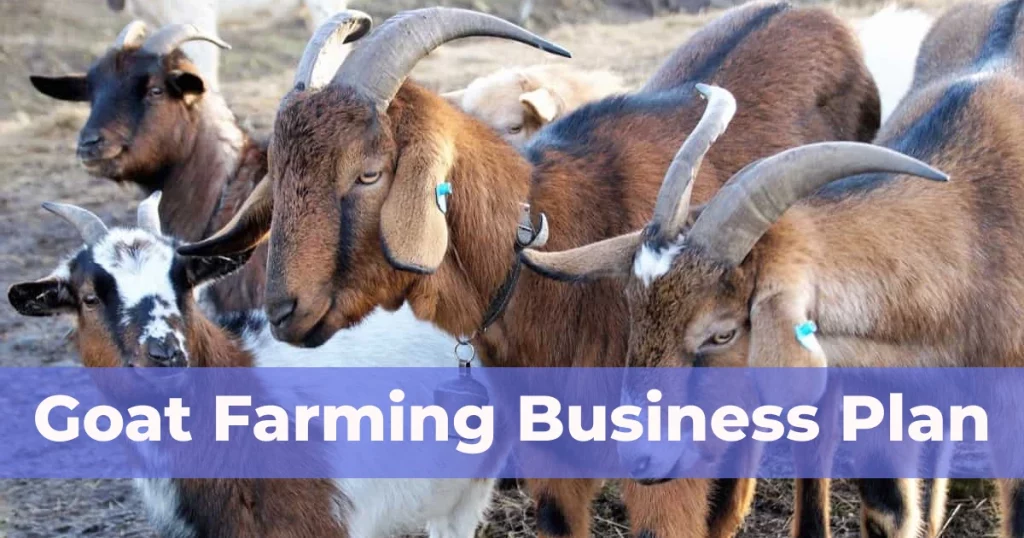Recently, the goat industry boomed in India with 20.45% of the share in the 20th Livestock Census, securing the 2nd position after cattle. Reason? Low set-up cost and profitable business! That’s why, folks are looking for a Goat farming business plan.
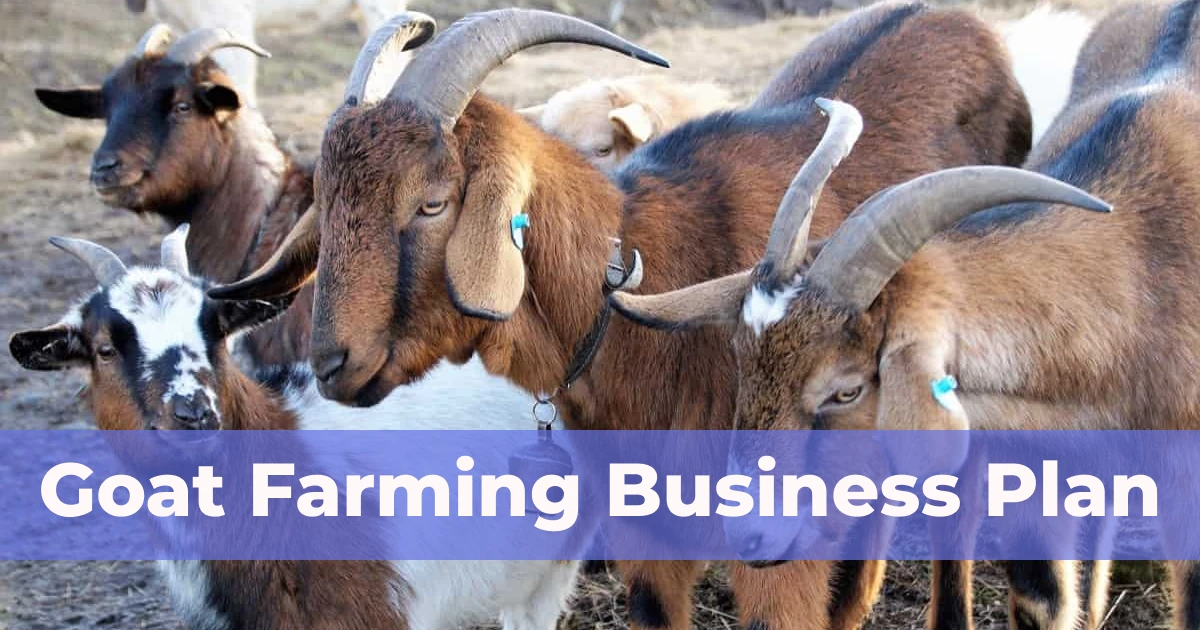
So, stick to this article because here we will be presenting the same!
(A) What is the Goat Farming Business Plan?
A goat farming business plan outlines the steps and strategies you’ll need to start and run a successful goat farm. It includes choosing the right breed (dairy, meat, or fiber goats), selecting a good location with enough space for grazing, and building proper housing for the goats.
The plan also covers feeding, healthcare, breeding practices, and marketing your products. It helps you manage resources, set goals, and foresee potential challenges. A clear business plan is essential for securing funding and guiding your farm to profitability.
(B) Key Components of Goat Farming Business Plan
Creating a goat farming business plan involves several key components that will guide you through starting and managing your farm effectively. Here are some of the key components that you must include in your plan-
- Executive Summary: This section gives a brief overview of your plan. It highlights the main points, including how much money you’ll need to start and the expected return on investment.
- Farm Description: Describe your farm’s location, size, and the facilities you will have. This includes the land for grazing, housing for goats, and any other amenities you plan to provide.
- Market Analysis: Look at the demand for goat products in your area. Identify who your competitors are and find out if there are any niche markets you can target to stand out.
- Sales & Marketing Plan: Set goals for selling your goat products. Define your target market, decide on your pricing strategy, and plan your marketing efforts to attract customers.
- Production Plan: Detail how you will raise your goats. Include information on their housing, feeding, breeding, and healthcare. Explain the practices you’ll use to ensure their well-being.
- Financial Plan: List the costs involved, such as buying goats, feed, fencing, housing, and equipment. Outline how you plan to generate income and achieve profitability.
- Appendix: Add any extra information that supports your business plan. This could include resumes, licenses, and permits.
By following these components, you’ll create a comprehensive plan that helps ensure the success of your goat farming business.
(C) How to start a Goat Farm business?
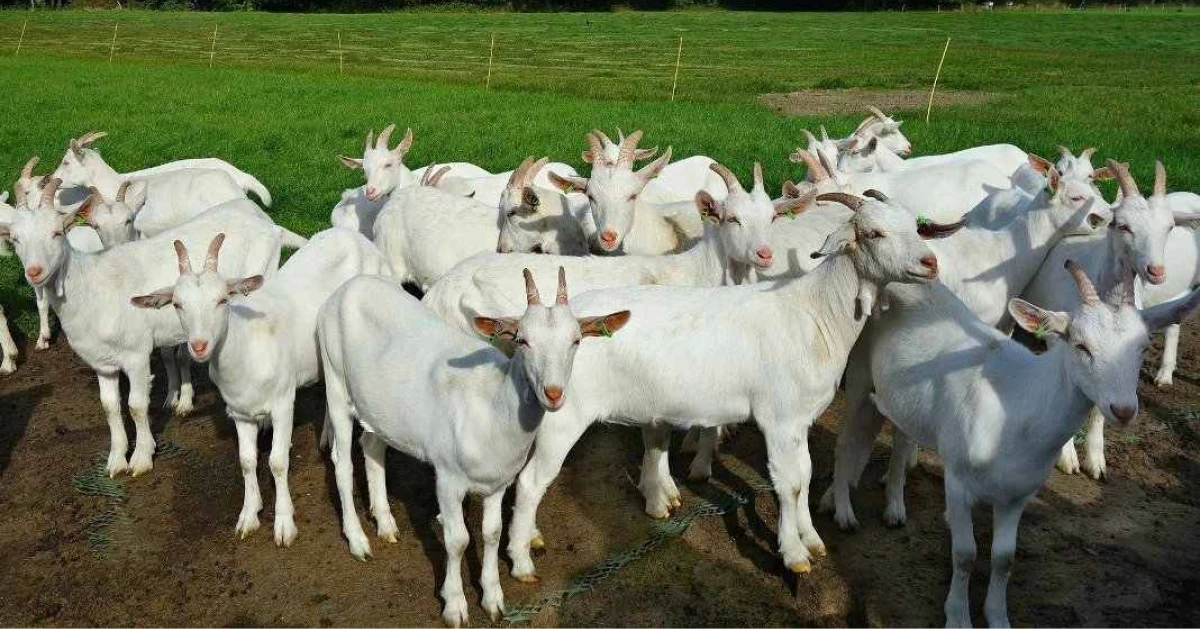
The first question that comes to the mind of beginners is the roadmap to start a Goat farm business. But you must know that the goat farm business must not only be profitable but sustainable as well.
Go through the following steps to have a thorough understanding on running a goat farm business-
(C.1) Get a Professional Training
The goat farming business sounds easy peasy- buy a few female goats, breed them, maintain them, and voila you’ll get a herd of goats within months offering meat, milk, and skin. Isn’t it?
But in reality, it is not a cakewalk. Having theoretical knowledge is good but practical knowledge and skills are the game changers in the business world. The same is the case with the goat farming business.
So, if you are a beginner, you must have proper training before starting the goat farming business. You can go through the following training programs (non-sponsored) recommended by Google-
- Complete Goat Farming Course- Build Profitable Business by Rocket Skills
- ICAR- Central Institute for Research on Goats
- ICAR- Skill Development Training on Profitable Sheep and Goat Farming
- Goat Farming Business Courses by the Institute for Industrial Development
Conduct thorough research before enrolling in any of the courses listed above. In case you want a detailed explanation of them, don’t hesitate to comment down below!
(C.2) Obtain Licenses & Permits
After gaining skills, the most important thing you need to do is to obtain the licenses and permits. This will ensure that your business is conducted within the law and free from any legal issues.
Here’s what you must do-
- Zoning Permits: Check with your local authorities for zoning permits related to agricultural use.
- Animal Handling Certification: Obtain certifications related to animal handling.
- Veterinary Clearance Certificate: This is necessary to ensure the good health of your goats before they become part of your commercial business.
- Registration with Government Agencies: Next you must register your farm as a business entity with an industry department or food safety board.
- NOC (No Objection Certificate): Don’t forget to obtain an NOC to address any objections that might arise in your area.
However, you must remember that regulations may vary by location, so it’s essential to check with your specific state or district’s animal husbandry department for precise requirements.
(C.3) Capital Investment
Now, here comes the most important part of the goat farming business. Like any business, you need to invest the capital depending on the size of the farm you’re admiring.
So, if you’re planning to start with a small herd of 12-15 goats, you need to invest Rs.50k to Rs.1 lakh
You see, the initial capital investment of the goat farming business is far less than that of the cattle farming business.
Note: We have thoroughly described the ideal dairy farming business plan to start and make a profit. You can go through it for detailed information.
(C.4) Selecting a Good Location for your Goat Farm
Choosing the right location for your goat farm is crucial for your success. Here’s what you need to consider-
- Availability of Fresh Water: First, make sure your farm area has a reliable source of fresh water. Goats need plenty of clean water to stay healthy, and having easy access to water will save you time and effort.
- Access to Food Sources: Next, check that there’s a good supply of food nearby, especially green foods. This will help keep your goats well-nourished and reduce your feeding costs.
- Proximity to Necessary Materials: All the materials you need for your farm must be easily available in your chosen area. This includes feed, medical supplies, and other farming equipment.
- Good Transportation System: A good transportation system is a must. You’ll need to move your products to market and bring supplies to your farm efficiently. Poor transportation can lead to delays and increased costs.
- Availability of Labor: Ensure there is a steady supply of full-time labor in the area. Reliable workers are key to managing your farm smoothly and taking care of your goats.
- Nearness to Markets: Finally, try to choose a location close to a market. This makes it easier to buy necessary supplies and sell your goat products. Being near a market can significantly boost your business by reducing transportation time and costs.
All these factors will set a strong foundation for your goat farming business.
(C.5) Determine the Goat Products for Your Farm
Deciding what products to produce from your goat farm is a crucial step. Goats are versatile animals that offer various products.
Visit your nearest market to understand which goat products are in high demand. Focus on producing items that you can easily sell locally to avoid losses.
Here’s a quick look at what you can produce from the goat business-
| Product | Description | Market Demand |
| Meat | Goat meat is popular worldwide and its demand is rapidly growing. About 70% of the globally consumed meat comes from goats. | High |
| Milk | Goat milk is nutritious and easily digestible, making it highly demanded locally and internationally. It’s also excellent for dairy products. | High |
| Fiber | For fiber, Cashmere and Angora goats are ideal. They produce high-quality fibers. | Niche but Valuable |
| Skin | While all goats produce skin, the Black Bengal goat produces high-quality skin that is highly valued internationally. | High (International) |
| Manure | Goat manure is an excellent fertilizer that can be used to enhance soil fertility. | Moderate |
Carefully decide based on what you can sell easily in your local market. For instance, if there’s a low demand for goat milk locally but a high demand for meat, it’s wiser to focus on meat production. Always align your production with market needs to ensure profitability.
(C.6) Choosing the right Goat Breed for Your Business
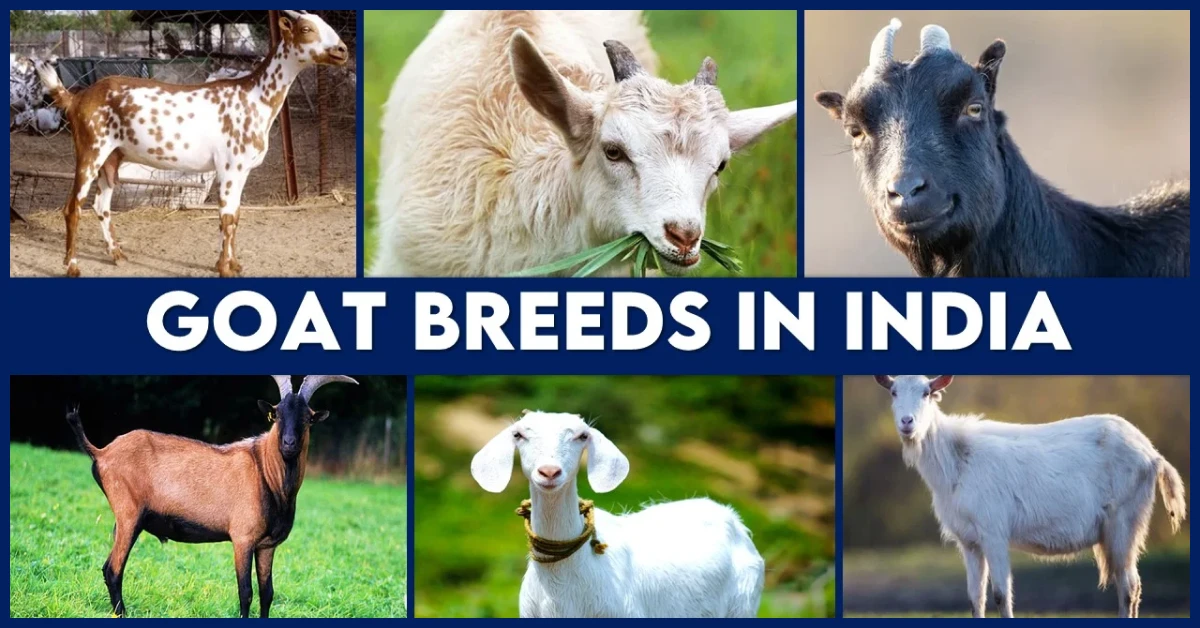
First, decide what you want to produce—meat, milk, or both. Your choice of breed should align with your production goals.
Best Meat Goat Breeds
If you aim to produce meat, consider these top breeds-
| Goat Breed (for Meat) | Description |
| Black Bengal | Known for high-quality meat. |
| Boer | Fast-growing and popular worldwide. |
| Kalahari Red | Hardy and good for extensive farming. |
| Kiko | Low maintenance and high growth rate. |
| Fainting | Good muscle quality, a unique trait. |
| Nubian | Dual-purpose, also good for milk. |
| Rangeland | Suitable for large-scale operations. |
| Sirohi | Adaptable to various climates. |
| Spanish | Excellent for brush control (weed removal) and meat. |
| Verata | Adaptable and good meat quality. |
Best Dairy Goat Breeds
For milk production, these breeds are the top choices-
| Goat Breeds (for Milk) | Description |
| Alpine | High milk yield, excellent quality. |
| Saanen | Known for large milk production. |
| LaMancha | Good milk quality with high butterfat. |
| Jamunapari | High milk yield, popular in India. |
| Toggenburg | Consistent milk producer. |
| Nubian | Dual-purpose, rich milk. |
| Oberhasli | Sweet milk, a good production rate. |
| Golden Guernsey | Rich, creamy milk. |
| Sable | Hardy with good milk yield. |
| Nigerian Dwarf | High butterfat content, smaller size. |
Best Dual Purpose Goat Breeds
Some breeds are excellent for both meat and milk production viz.-
| Goats Breed (Milk + Meat) | Description |
| Nubian | High-quality meat and rich milk. |
| Alpine | Good milk producer and substantial meat. |
| Nigerian Dwarf | Small size, high butterfat milk, good meat. |
After determining your production goal and reviewing the available breeds, choose the breed that best fits your needs and is readily available in your area. This will ensure your farm operates smoothly and profitably.
(C.7) Purchase Required Equipment for Your Goat Farm
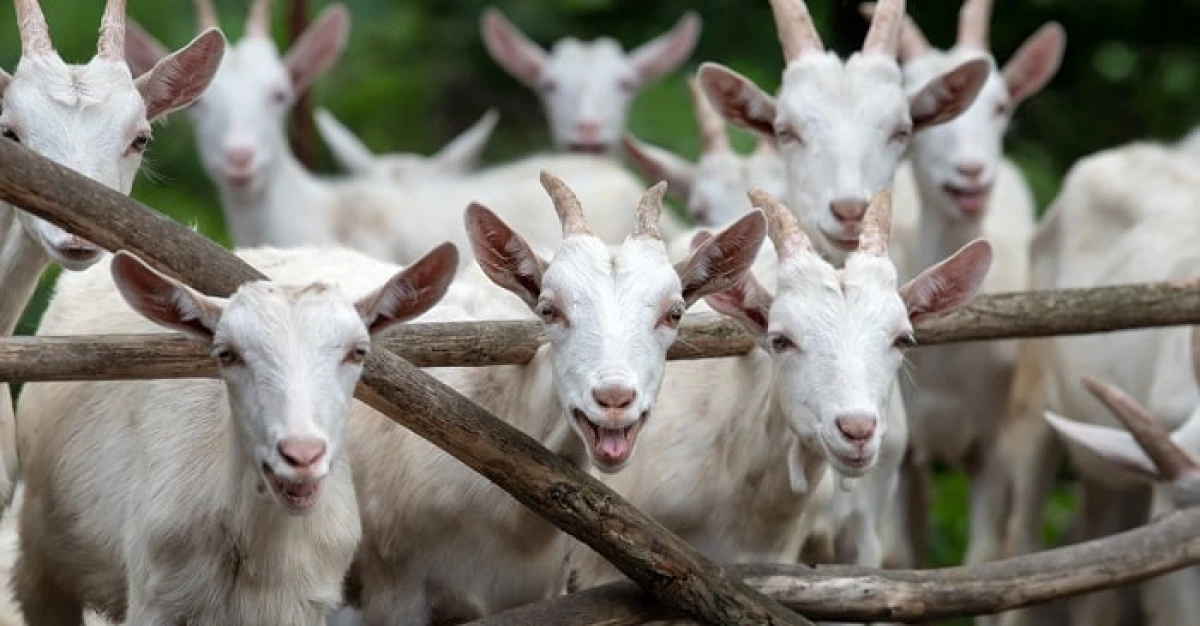
To run a successful goat farm, you need the right equipment. You will need the following things-
- Fencing: Strong and secure fencing is essential to keep your goats safe from predators and prevent them from wandering off. You can buy pre-made fencing or build it yourself using materials like wire mesh and wooden posts.
- Shelter or Pen: Goats need a comfortable and safe shelter to protect them from harsh weather conditions. This could be a simple shed or a more elaborate pen, depending on your budget and resources. Ensure the shelter is well-ventilated and spacious enough for all your goats.
- Feeding Racks: Feeding racks are necessary to keep the feed clean and reduce wastage. You can purchase ready-made racks or create your own using wood or metal. Properly designed racks make feeding easier and more efficient.
- Water Supply: A reliable water supply system is crucial. Goats need constant access to fresh, clean water. You can use automatic waterers or simple troughs, but ensure they are regularly cleaned and refilled.
- Loafing Sheds: Loafing sheds provide a shaded area where goats can rest and relax. These sheds should be sturdy and offer protection from the sun and rain. You can build them using basic materials like wood and metal roofing.
- Feeds or Silage Storage: Proper storage for feeds and silage ensures your goats always have access to nutritious food. Use bins or storage sheds to keep feed dry and protected from pests. You can purchase these or construct simple storage units yourself.
- Animal Sick Bay: An animal sick bay is a designated area for isolating and treating sick goats. This helps prevent the spread of diseases and allows for proper care. Equip the sick bay with basic medical supplies and ensure it’s easily accessible.
- Manure Handling Bay: A manure handling bay is essential for managing waste efficiently. It helps keep the farm clean and reduces odors. You can use a simple composting area or invest in more advanced manure management systems.
- Making your Purchases: You can purchase most of this equipment from agricultural supply stores or online. For items like feeding racks and shelters, you might also consider DIY options to save costs.
By ensuring you have all the necessary equipment, you’ll be well-prepared to manage your goat farm effectively and keep your animals healthy and productive.
(C.8) Goat’s Nutrition & Food
Feeding your goats with high-quality, nutritious food is crucial for the success of your goat farming business. Here’s how to ensure your goats get the best nutrition-
- Natural Grazing: Allows goats to get nutrition from pasture.
- Commercial Feed: Highly nutritious but more expensive.
- Mixed Feeding: Combines natural grazing with commercial feed to balance cost and nutrition.
Now, let’s look at the details-
Grazing and Natural Sources
Goats are ruminants, meaning they can eat a wide variety of crops, grains, and greens. If you have a grazing area where your goats can roam freely, that’s ideal. Grazing allows goats to get most of their nutrition naturally, which not only keeps them healthy but also reduces your feeding costs.
Grazing offers the following benefits-
- Cost Effective: Grazing minimizes the need for commercial feed, lowering your expenses.
- Healthier Goats: Natural grazing helps goats stay active and healthy.
- Environmental Balance: Grazing can help manage pasture and maintain ecological balance.
However, if you don’t have a proper grazing field then you need to go for commercial feed.
Commercial Goat Feed
You can also provide your goats with commercially prepared feed. These feeds are formulated to meet all the nutritional needs of goats, ensuring they get the right balance of proteins, vitamins, and minerals.
Combining Feeding Methods
To optimize costs and nutrition, consider a mixed feeding approach. Allow your goats to graze and supplement their diet with commercial feed. This ensures they receive all necessary nutrients without relying entirely on the more expensive commercial options.
Apart from goat’s food, you must keep the following points in mind-
- Balanced Diet: Ensure the goats’ diet includes a variety of greens, grains, and commercial feed to meet all their nutritional requirements.
- Clean Water: Always provide access to fresh, clean water to support digestion and overall health.
- Monitor Health: Regularly check the health of your goats to ensure they are getting the right nutrition and adjust their diet as needed.
That’s how you can keep your goats healthy and productive…
(C.9) Breeding Management in Goat Farming
Effective breeding management is crucial for the productivity and health of your goat farm.
You must consider the following reproductive parameters-
| Parameters | Details |
| Breeding Age | 6-8 months |
| Heat After Lambing | 21 days |
| Pregnancy Length | 147 days (144-152 days range) |
| Male-to-Female Ratio | 1:20 |
| Estrous Cycle | 19-21 days (17-24 days in Does) |
| Estrous Duration | 24-36 hours in ewes, 34-38 hours in Does |
Here is a detailed guide to help you understand and implement best breeding practices-
- Male to Female Ratio: Maintain a ratio of one male (buck) to 20 females (Does). This ensures that the buck is not overworked and can mate effectively with the Does.
- Age & Experience: Young bucks should mate with experienced Does, and older bucks should mate with younger Does. This improves mating success and reduces stress on the animals.
- Avoid Inbreeding: To prevent genetic problems, avoid inbreeding. Replace or exchange bucks every two years to introduce new genetics and maintain herd health.
- Breeding Age: Does should be 18 to 24 months old before breeding, depending on their body condition. Breeding too young can result in weak offspring and higher mortality rates.
- Body Weight: The body weight of Does at breeding should be less than their adult body weight to ensure they are fit for breeding and pregnancy.
- Estrous Detection: Detect estrous (heat) in females over one year old using an aproned or vasectomized buck. This should be done both morning and evening during the breeding season (September to October, February to March, and May to June).
- Synchronization and Conception: To synchronize breeding, use hormonal treatments or allow bucks and Does to see each other a week or two before the breeding season. For a 90% conception rate, keep one buck with up to three Does in heat together for a day or night over three cycles. Two services 8 to 12 hours apart can improve conception rates.
- Separation of Pregnant Does: Does that don’t return to estrous after two cycles are likely pregnant. Separate them from non-pregnant Does to prevent stress and fighting. Keep pregnant Does in groups of 15 to 20.
- Breeding Seasons: Avoid kidding during peak winter to protect kids from cold and pneumonia. Plan breeding for summer (May 15 to June 15) to ensure kids are born in favorable conditions.
- Nutrition: Ensure Does are well-fed throughout pregnancy. Even short-term starvation can lead to embryo loss.
Estrous Signs
Signs of estrous include reddening and discharge from the vulva, tail wagging, mounting other animals, seeking males, frequent bleating, and standing for mating.
Prevention of Unwanted Pregnancy in Goats
- Using an Intact Male: The male identifies estrous Does, but control is necessary to prevent unwanted mating.
- Aproned Male: Apron prevents mating while allowing estrous detection.
- Vasectomized Male: Identifies estrous Does without the risk of fertilization.
Mating Methods
- Hand Mating: One-on-one mating, a controlled environment.
- Pen Mating: Groups of 20-25 Does, males introduced at night.
- Flock/Pasture Mating: Males run with females, less control but natural behavior.
- Artificial Insemination: Controlled breeding, lower conception rates, especially with frozen semen.
By following these breeding management practices, you can ensure healthy, productive, and genetically diverse goat herds.
(C.10) Monitoring Health Conditions and Caring for Your Goats
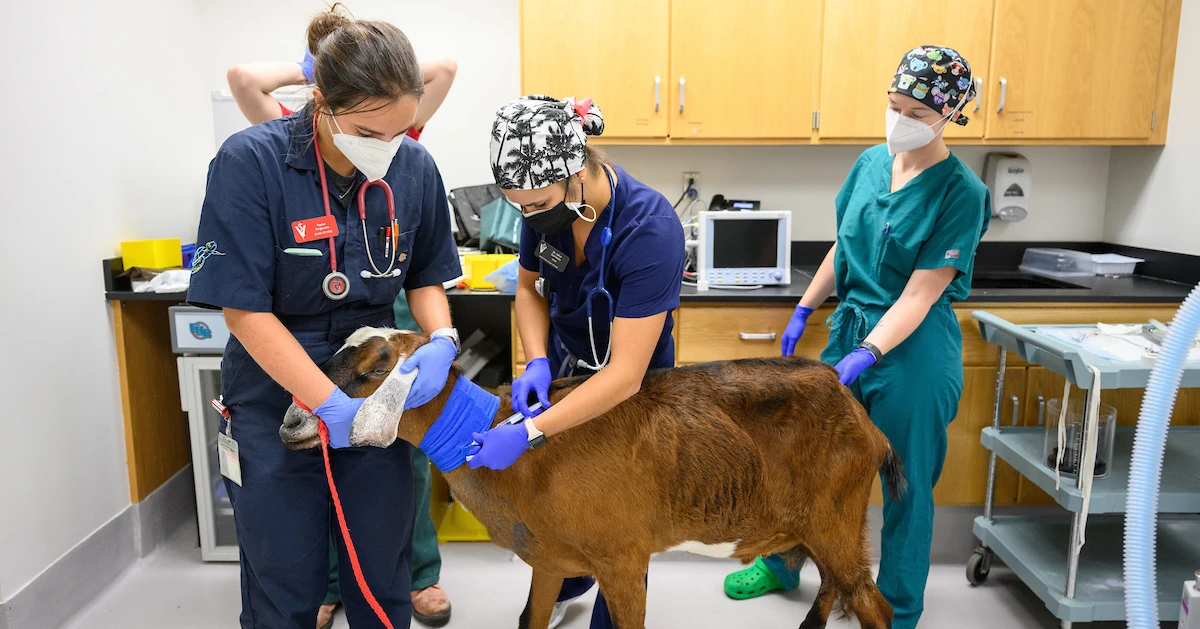
Ensuring the health and well-being of your goats is essential for a successful goat farming venture. Here’s how to effectively monitor their health and provide proper care-
Hygienic Practices
Maintain hygienic conditions in your goat farm to prevent the spread of diseases. Keep the barn clean and regularly remove waste. Provide clean water and feed to your goats to promote good health.
Veterinary Care
Establish a good relationship with a veterinarian in your area. Consult them regularly for advice and assistance with any health issues that may arise. Keep a stock of necessary vaccines and medicines on hand to address common health concerns promptly.
Regular Health Checkups
Conduct regular health checks on your goats to detect any signs of illness or health issues early. Monitor their behavior, appetite, and physical condition closely. Seek veterinary assistance if you notice any abnormalities or concerns.
Vaccination Schedule
Follow a strict vaccination schedule to protect your goats from common diseases. Vaccinate them timely according to the recommendations provided by your veterinarian. This helps prevent outbreaks and ensures the overall health of your herd.
Here is the vaccination schedule for goats-
| Name of the Disease | Primary Vaccination | Regular Vaccination |
| Anthrax | At the age of 6 months | Once Annually (in affected areas only) |
| Haemorrhagic Septicemia (H.S.) | At the age of 6 months | Once Annually before monsoon |
| Enterotoxaemia | At the age of 4 months if the mother is vaccinated; At the age of 1st week if the lamb is not vaccinated | Before monsoon; Booster dose after 15 days of 1st vaccination |
| Black Quarter (B.Q.) | At the age of 6 months | Once annually before monsoon |
| Peste Des Petits Ruminanat (PPR) | At the age of 3 months | Once in 3 years. |
| Foot & Mouth Disease (FMD) | At the age of 4 months | Twice in a year (September & March) |
| Goat Pox | At the age of 3 months | Once Annually (December) |
By prioritizing the health and well-being of your goats and implementing proper care practices, you can maintain a healthy and thriving goat farm.
(D) Budget Planning for Goat Farming Business
- Buying Goats: When you’re starting your goat farm, it’s important to get your goats at the right price. Look for deals nearby to save on transportation costs. For instance, buying 60 female goats and five male goats could cost you around Rs.4 lakh.
- Feed Expenses: Feeding your goats is a big part of your budget. You’ll need about 3 kg of feed for each kg of weight gain for kids and 0.2 kg for adult goats every day. Overall, feeding all your goats could cost about Rs.1.35 lakh, including transport.
- Other Costs: Besides feeding, there are other expenses to consider. You’ll need to build shelters, budgeting around Rs.1.60 lakh. Don’t forget about vaccinations, medical care, labor, and growing green fodder, which could add up to around Rs.2.16 lakh.
- Returns & Profits: Your hard work should pay off! Selling around 90 kids could bring in about Rs.3.10 lakh in profit. After subtracting your running costs of Rs.1.89 lakh, you could be left with Rs.1 lakh in profit.
(E) Return on Investment (ROI) of Goat Farming Business Plan
Your ROI measures how much you’ll get back compared to what you put in. With a Rs.7 lakh investment, you could see an ROI of 1.5 to 2 over the first three years.
In other words, ROI is all about how profitable your goat farm is. A well-run farm could bring in 20% to 40% more than you invested every year. So if you put in Rs.1 lakh, you might get back Rs.20,000 to Rs.40,000 every year.
Your ROI can change based on things like the kinds of goats you have, how you take care of them, and how much people want goat products. It might go up or down because of things like diseases or changes in the market.
(F) Profit Calculation
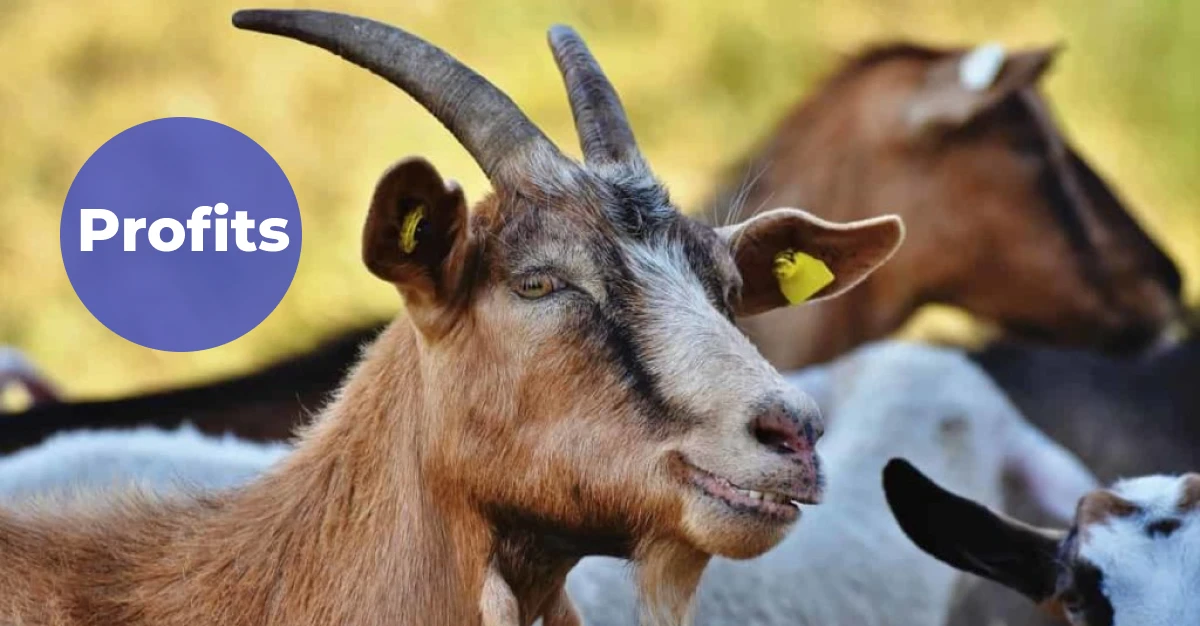
You could make around Rs.30,000 in profit every six months, but it depends on the kind of goats you have and where you’re farming. And if you grow your goat food yourself, you could make even more money!
What I mean is taking good care of your goats, making sure they stay healthy, and finding the right buyers can help you make more money. And if you grow your own goat food, you could save a lot on feed costs, making your profits even bigger.
(G) Final Words: Is it worth it?
Starting a small goat farm might sound like a big deal, but with the right planning, it could pay off. It could cost you anywhere from Rs.1.5 lakh to Rs.3 lakh to start, but you could make between Rs.1.5 lakh and Rs.3.5 lakh every year if you do it right!

